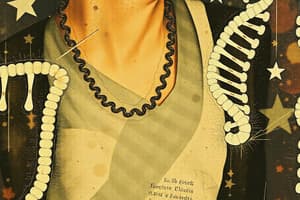Podcast
Questions and Answers
What forms the 'sides' of the DNA double helix?
What forms the 'sides' of the DNA double helix?
- Ribose sugar
- Amino acids
- Base pairs
- Sugar-phosphate backbone (correct)
Which of the following statements accurately describes RNA?
Which of the following statements accurately describes RNA?
- It contains thymine instead of uracil.
- It primarily functions in storing genetic information.
- It has a ribose sugar backbone. (correct)
- It is double-stranded like DNA.
What is the primary function of messenger RNA (mRNA)?
What is the primary function of messenger RNA (mRNA)?
- To store genetic information.
- To deliver genetic information from DNA to ribosomes. (correct)
- To form part of the ribosome structure.
- To carry amino acids to ribosomes.
How many pairs of chromosomes do humans have?
How many pairs of chromosomes do humans have?
What is the role of ribosomal RNA (rRNA) in the cell?
What is the role of ribosomal RNA (rRNA) in the cell?
What determines the sex of an individual in humans?
What determines the sex of an individual in humans?
Which of the following best describes the role of proteins in relation to DNA?
Which of the following best describes the role of proteins in relation to DNA?
What happens during DNA replication?
What happens during DNA replication?
Flashcards
DNA structure
DNA structure
A double-stranded helix with base pairs (A-T, G-C) forming the rungs and sugar-phosphate backbone forming the sides.
RNA function
RNA function
Carries genetic information from DNA to ribosomes (mRNA), delivers amino acids to ribosomes (tRNA), and is part of ribosomes (rRNA).
Chromosome role
Chromosome role
Organized structures with DNA and proteins that condense during cell division and carry genes for traits.
DNA replication
DNA replication
Signup and view all the flashcards
Gene function
Gene function
Signup and view all the flashcards
Base pairing in DNA
Base pairing in DNA
Signup and view all the flashcards
Chromatin vs. Chromosome
Chromatin vs. Chromosome
Signup and view all the flashcards
DNA-RNA relationship
DNA-RNA relationship
Signup and view all the flashcards
Study Notes
DNA Structure and Function
- DNA (deoxyribonucleic acid) is a double-stranded helix, resembling a twisted ladder.
- The "rungs" of the ladder are composed of complementary base pairs: adenine (A) with thymine (T), and guanine (G) with cytosine (C).
- The sugar-phosphate backbone forms the "sides" of the ladder.
- DNA stores genetic information in the sequence of these base pairs.
- DNA replication is a crucial process where the double helix is unwound and each strand serves as a template for a new complementary strand.
- This ensures accurate transmission of genetic information during cell division.
- DNA's structure allows for storage and transmission of complex genetic information.
RNA Structure and Function
- RNA (ribonucleic acid) is a single-stranded molecule.
- It contains ribose sugar instead of deoxyribose, and uracil (U) replaces thymine.
- Different types of RNA exist, with distinct roles:
- Messenger RNA (mRNA): Carries genetic information from DNA to ribosomes.
- Transfer RNA (tRNA): Delivers amino acids to the ribosomes during protein synthesis.
- Ribosomal RNA (rRNA): Forms part of the ribosome, the site of protein synthesis.
Chromosomes
- Chromosomes are organized structures composed of DNA and proteins.
- They condense during cell division for efficient distribution.
- Each species has a characteristic number of chromosomes.
- Humans have 23 pairs of chromosomes, with one set inherited from each parent.
- Autosomes are the non-sex chromosomes.
- Sex chromosomes determine the sex of an individual (XX for female, XY for male).
- Chromosomes contain many genes, which are segments of DNA that code for specific proteins.
- Genes hold instructions for building and maintaining an organism.
- DNA is packaged into chromatin, then into chromosomes, allowing it to fit within the cell's nucleus.
- Tightly packaged DNA is harder to access by transcriptional machinery.
- The process of packaging and un-packaging of DNA influences gene expression.
DNA, RNA, and Chromosomes Relationship
- DNA contains the genetic code.
- DNA is transcribed into messenger RNA (mRNA).
- The mRNA is translated into proteins in the ribosome, a structure made up of rRNA and protein.
- Chromosomes organize and package DNA in the nucleus.
- Proteins associate with DNA to regulate gene expression (transcription factors).
- RNA plays a crucial intermediary role between DNA and proteins.
- The relationships between DNA, RNA, and chromosomes are critical to cellular function.
- Errors in DNA replication or expression can lead to genetic diseases.
Studying That Suits You
Use AI to generate personalized quizzes and flashcards to suit your learning preferences.




